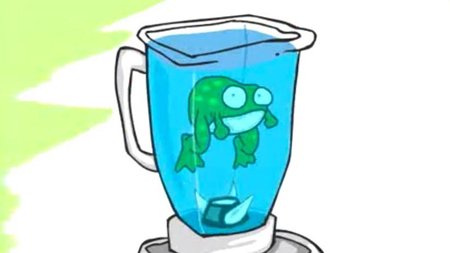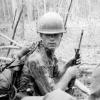A Strategic Guide to Afghanistan Options
Keith Nightingale
Afghanistan has become an intractable problem absent any clear acceptable strategic solutions. It is our national tar baby. Most simply, it is a mess. We are there. We would like to get out. What are our options? A small brief for our strategic planners.

First, visualize a large pond-sized blender. Insert six frogs. Hit pulse several times.
Desire the frogs to emerge and make the pond a better place.
Currently, our sticky strategic plan for Afghanistan is the pond, frog, and pulse arrangement. So what are our reasonable options for a resolution to the Afghanistan tar baby in a briar patch? Gen. H.R. McMaster has limited options and none result in sunlight and smiles. And in the reality of all crisis situations at the national level, no decision is, in fact, a decision. So what are our options?
Hold the finger.
Course of Action A
Fully withdraw. Combatus Interruptus. A decisive step that allows the bad guys free reign to re-instate all the bad stuff we went in to eradicate a generation ago. While it does get us out and reduces a great number of casualties and expenses, the future political blowback will probably be too great to accept. Why did we go there in the first place? Why did all those people get killed? Add a year and we will probably clamor to return to eliminate the AQ/ISIS/Talib reincarnated bed of bad guys and to re-instate education for adolescent females. An unlikely approach to either birth or battle control.
Course of Action B
Re-Surge: More is better - stuff in more troops. Fight for more territorial control. Kill more bad guys with a competent military force and hang around. How long? Do we replace our replacements as they attrit? What do we do with the forces when the areas they occupy (operative word-think COIN) are reasonably pacified? Been there. Done that. Massive domestic blowback will likely occur as we have no apparent plan to achieve an enlightened wholly competent Afghan government where there is no glimmer of life in that possibility anyone can presently see. Feel good now. Feel bad later and back to Square One.
Course of Action C
Stay the Course: Head down in the scrum-Push along. Eventually something may emerge. Or not. But, we keep trying……How long do we keep trying? Can we scrum along to the point where there is a decisive loss of interest by the Great American Public? Think daily Bleed and Lead media feeds. In time, we hope the locals can create some form of viable government and hope and hope. Minimal short term pain as we are in the blender now and not required to offer any brand new ideas to a long lasting condition. Maybe fairy dust will enshroud us and make everyone happy. Wishing and hoping is not a strategy as General Abazaid famously informed then Senator Clinton.
Course of Action D
Regional Focus: Kumbaya! Build a brilliant Trans-National/Regional Strategy that has all our allies and enemies working together to build a stable, viable Afghanistan. Using selfish self-interest and clever diplomatic ploys, we get the Chinese and Russians to pressure their friends and allies to work on our behalf. We convince the Paks to renounce their children in the guise of the Taliban and convince the Indians to back off the Paks if the Paks act nice. The Mid-East Sunni states, at our behest, renounce all support (overt and covert) to the AQ and Talib elements and throw their support behind the mayor of Kabul. Iran, with a wave of new-found insight, decides that the US is not the evil Satan and that a stable Afghanistan is just what Allah ordered. Meanwhile, the Afghan government significantly reduces its corruption, adapts liberal Western democratic reforms, and conducts field security operations in a highly professional and un-coached manner. Everyone has their finger on the pulse button, but no one pushes it. This strategy is reserved for discussions at your nearest Cannabis club.
Course of Action E
Fortress America. Our far-flung launch pad of democratic ideals. Afghanistan is our great National Forward Operating Base. We launch regional initiatives to spread sweetness, light, education for females, and great democratic family values to the region. This Course of Action requires; reasonable security (our SOF and conventional troops hard at continuous work); a compliant Afghan government that grants basing rights and SOFA agreements and accepts long term subordination to US interests (keep that Aid flowing etc); a happy Congress willing to eternally fund our expeditionary entity; a domestic populace of happy-think re-election- voters to support an unending stream of manpower, money, and to disregard bleed/lead headlines on a nightly basis. See Cannabis club above.
Course of Action F
Merlin the Magician. By brilliant planning, superb execution, and the intervention of a merciful God, a hybrid frog emerges that cannot presently be seen. This frog leads us out of the pond and into a land of eternal sunshine and abundant mosquitoes. Wishing and hoping is the key ingredient for success.
Just like the frogs, we are all in this international processor without a likely positive outcome that satisfies all our basic desires. In every option, multiple players have a finger on the pulse button. Nothing is easy or simplistic in today’s unhappy world as we swim in roiled waters.
Welcome to the real world. Pick your poison based on desirable effects. Antidotes remain to be discovered.
NOTE to the National Security Council: All frogs have warts. If kissed, no frog will become a Prince. But, you must and will, pick a Course of Action. Again, no decision is a decision.
NOTE to all parties filled with bright ideas: Submissions must not exceed one page from concept to likely outcome which will, realistically, produce no prince.
General McMaster is not a Prince, but he must assume the mantle of a Saint.
About the Author(s)
Comments
Given Russia's involvement in Afghanistan -- and elsewhere today -- should we consider Afghanistan in the context of the New/Reverse Cold War (the U.S./the West now doing expansion; the Russians today now doing containment and roll back)?
BEGIN QUOTE
The revelation that Russia is covertly supporting U.S. enemies in Afghanistan makes the political case for increasing a counterterrorism partnership that much trickier. And it further expands the global chessboard on which Moscow is playing against the West. ...
The upshot of it all, however, is that Russia and the United States have effectively switched roles in Afghanistan: In the 1980s, American CIA officers supplied weapons to anti-government rebels who were fighting the then-Soviet backed government and the Soviet troops supporting it. Today, 15 years after the American invasion, Russia has begun helping the Taliban against a weak American-backed government still supported by NATO troops and airpower.
END QUOTE
http://www.npr.org/2017/02/13/515020244/why-is-russia-helping-anti-u-s-…
If we factor this in (the New/Reverse Cold War noted above; wherein, Russia joins with others states -- and with non-state actors also -- to thwart U.S./Western efforts to advance market-democracy throughout the world), then how does this effect our strategic choices:
a. Those noted above by COL Nightingale? And/or
b. Those other/different strategic choices that we might consider in the context of a New/Reverse Cold War?
Or does the Brexit, the election of President Trump, etc., signal that this New/Reverse Cold War has ended even before it got really got off the ground; this, because the U.S./the West has already been defeated (much as was the case with the Soviets/the communists before us) re: our worldwide expansionist designs? (Both U.S./Western politicians -- and indeed our populations also -- today being in more of an "isolationist," rather than in more of an "expansionist," mood?)
(Thus, much as Afghanistan was "lost" to the Soviets/the communists -- at the same time that they "lost" the Old Cold War -- likewise to see our imminent departure from Afghanistan as signaling that our expansionist and universalist designs -- that these also have come to an end?)
Bottom Line:
Before we can reasonably reflect on a "Strategic Guide to Afghanistan Options,"
A new "Strategic Guide to U.S./Western Interests and Ambitions" must -- somehow -- (a) be articulated and (b) be understood.
Yes?
The problem with Plan B-even if done full up- is that there has to be a "rest of the story" that converts the temporary secured condition into one that is long lasting and self-sustaining absent US/NATO military. That is where the problem begins. The Afghans have showed consistently that they are incapable of creating viable government entities once we leave.
Plan B? Was never fully implemented.
Of the 40,000 US troops requested as a minimum for a Surge no more than 25,000 were ever in strength, troops were shuffled around and another 10,000 foreign troops added but it never reached the max that this author has glossed over.
I have only started to read the Cordesman assessment and what is most confusing is that the Us Military is being tasked with jobs better left to NGOs and contractors while letting the military act like the military.
What the military is doing is adding to its SF force in Afghanistan and doubling the number of drones.

